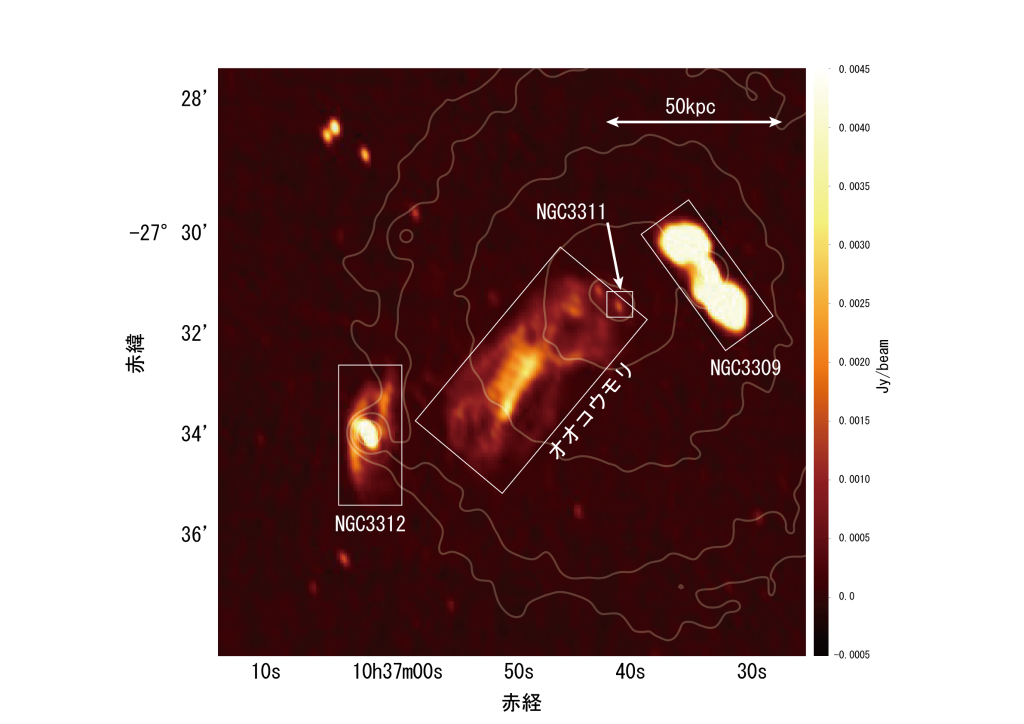[Research] Discovery of Mysterious Radio Emissions in the Hydra Cluster

Abstract
Our groups, led by Associate Professor Kazuhiro Nakazawa at Nagoya University/KMI and first-year Ph.D. student Yuki Omiya at the Graduate School of Science, in collaboration with a research team led by Project Researcher Kohei Kurahara at the Mizusawa VLBI Observatory, National Astronomical Observatory of Japan (NAOJ), discovered an extended radio emission in the Hydra cluster, about 150 million light-years away.
Galaxy clusters are the largest self-gravitating objects in the Universe, surrounded by hot gas, magnetic fields, and cosmic rays energized by past collisions. Previous studies have suggested that the Hydra cluster has undergone collisions and mergers over the past several billion years, but no symptoms have been found.
Kurahara and his colleagues discovered a new extended radio emission that had never been classified before by analyzing multiple radio observation data. We named it “Flying Fox” based on its shape in the image. Our team analyzed the X-ray observation data and confirmed that the gas around this region has a slightly high abundance. This fact suggests that high-temperature gas with high-abundance near the galaxy at the center of the cluster has been ejected along with the Flying Fox. It means that there is motion of high-temperature gas in the cluster. The XRISM satellite, launched just last year, will reveal more details.
The paper was published as a letter paper, “Discovery of Diffuse Radio Source in Abell 1060”, in the “Publications of the Astronomical Society of Japan (PASJ)” in April 2024.
Scientific Backgrounds
We first discovered extended radio emission in the Hydra cluster, about 150 million light-years away. This discovery makes clear the necessity of low-frequency radio observations and the importance of comparing them with high-temperature gas observed in X-rays. It will also open new avenues for understanding the evolution of galaxy clusters.
Galaxy clusters are the largest massive objects in the Universe, with enormous gravitational energy. They are surrounded by hot gas (several hundred million degrees Celsius), magnetic fields, and cosmic rays, which are thought to be produced by the conversion of gravitational energy. In reality, however, how the energy conversion takes place is still not fully understood. A merger of galaxy clusters is thought to release the enormous gravitational energy of each cluster, and is an important research target for understanding the evolution of galaxy clusters and the origin of high-energy cosmic rays. The Hydra cluster (Abell 1060) is the closest cluster to Earth in the northern sky and has been the subject of much research. Previous research has suggested that the Hydra cluster has collided and merged over the past several billion years, but no observational symptoms such as high-energy cosmic rays or peculiar spatial structure of high-temperature gas have been found from collisions and mergers, leaving it a major mystery.
Our groups, led by Associate Professor Kazuhiro Nakazawa at Nagoya University/KMI and first year Ph.D. student Yuki Omiya at the Graduate School of Science, in collaboration with a research team led by Project Researcher Kohei Kurahara at the Mizusawa VLBI Observatory, National Astronomical Observatory of Japan (NAOJ), first discovered the Hydra cluster using the data archive of the GMRT (Giant Metrewave Radio Telescope) observed in December 2010. Kurahara and his colleagues also confirmed its existence, albeit at a lower angular resolution, by examining the data archive of further lower frequency observations by the Murchison Widefield Array (MWA) using a technique to improve sensitivity. We have also examined the data archives of optical and other observations in this region, but have found no clear correspondence with the source. Therefore, we believe that this is a new radio emission that has never been classified before. The radio emission was named “Flying Fox” because of its shape in the image. Our team at Nagoya University analyzed data observed by the X-ray astronomy satellite XMM-Newton. It showed that although there is no significant structure in the X-ray image, the gas around this region has a slightly high abundance. This fact suggests that high-temperature, high-abundance gas has been ejected near the galaxy at the center of the cluster along with the Flying Fox.
Paper Information
Journal: Publications of the Astronomical Society of Japan(PASJ)論文タイトル:Discovery of Diffuse Radio Source in Abell 1060
Authors: Takuya AKAHORI(1), Kohei KURAHARA(1), Aika Oki (2), Yuki OMIYA(3), Kazuhiro NAKAZAWA(3, 4)
(1) Mizusawa VLBI Observatory, National Astronomical Observatory Japan, 2-21-1 Osawa, Mitaka, Tokyo 181-8588, Japan
(2) Department of Astronomy, Graduate School of Science, The University of Tokyo, 7-3-1 Hongo, Bunkyo-ku, Tokyo 113-0033, Japan
(3) Department of Physics, Nagoya University, Furo-cho, Chikusa-ku, Nagoya, Aichi 464-8601, Japan
(4) Kobayashi-Maskawa Institute for the Origin of Particles and the Universe, Furo-cho, Chikusa-ku, Nagoya, Aichi 464-8601, Japan
DOI:10.1093/pasj/psae011
URL: https://doi.org/10.1093/pasj/psae011



